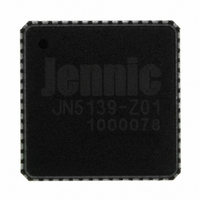JN5139-Z01-V NXP Semiconductors, JN5139-Z01-V Datasheet - Page 21

JN5139-Z01-V
Manufacturer Part Number
JN5139-Z01-V
Description
IC MCU ZIGBEE 32BIT 2.4G 56QFN
Manufacturer
NXP Semiconductors
Series
JN5139-Z01Rxr
Specifications of JN5139-Z01-V
Frequency
2.4GHz
Modulation Or Protocol
802.15.4 Zigbee
Applications
General Purpose
Power - Output
3dBm
Sensitivity
-97dBm
Voltage - Supply
2.2 V ~ 3.6 V
Current - Receiving
34mA
Current - Transmitting
34mA
Data Interface
PCB, Surface Mount
Memory Size
96kB RAM, 192kB ROM
Antenna Connector
PCB, Surface Mount
Operating Temperature
-40°C ~ 85°C
Package / Case
56-QFN
Lead Free Status / RoHS Status
Lead free / RoHS Compliant
Data Rate - Maximum
-
Other names
616-1034-2
935293943515
JN5139-Z01-AI
JN5139-Z01-V
JN5139-Z01R1-ARV
JN5139-Z01R1V
935293943515
JN5139-Z01-AI
JN5139-Z01-V
JN5139-Z01R1-ARV
JN5139-Z01R1V
7 Interrupt System
The interrupt system on the JN5139 is a hardware-vectored interrupt system. The JN5139 provides several interrupt
sources, some associated with CPU operations (CPU exceptions) and others which are used by hardware in the
device. When an interrupt occurs the CPU stops executing the current program and loads its program counter with a
fixed hardware address specific to that interrupt. The interrupt handler or interrupt service routine is stored at this
location and is run on the next CPU cycle. Execution of interrupt service routines is always performed in supervisor
mode. Interrupt sources and their vector locations are listed in Table 2 below:
7.1 System Calls
Executing the l.sys instruction causes a system call interrupt to be generated. The purpose of this interrupt is to
allow a task to switch into supervisor mode when a real time operating system is in use, see section 3 for further
details. It also allows a software interrupt to be issued, as does execution of the l.trap instruction.
7.2 Processor Exceptions
7.2.1 Bus Error
A bus error exception is generated when software attempts to access a memory address that does not exist, or is not
populated with memory or peripheral registers.
7.2.2 Alignment
Alignment exceptions are generated when software attempts to access objects that are not aligned to natural word
boundaries. 16-bit objects must be stored on even byte boundaries, while 32-bit objects must be stored on quad byte
boundaries. For instance, attempting to read a 16-bit object from address 0xFFF1 will trigger an alignment exception
as will a read of a 32-bit object from 0xFFF1, 0xFFF2 or 0xFFF3. Examples of legal 32-bit object addresses are
0xFFF0, 0xFFF4, 0xFFF8 etc.
7.2.3 Illegal Instruction
If the CPU reads an unrecognised instruction from memory as part of its instruction fetch, it will cause an illegal
instruction exception.
© NXP Laboratories UK 2010
Interrupt Source
Reset
Bus Error
Tick Timer
Alignment
Illegal Instruction
Hardware Interrupts
System Call
Trap
Vector Location
0x100
0x200
0x500
0x600
0x700
0x800
0xC00
0xE00
Table 2: Interrupt Vectors
Interrupt Definition
Software or hardware reset
Bus error or attempt to access invalid physical address
Tick Timer expiry
Load/Store to naturally not aligned location
Illegal instruction in instruction stream
Hardware Interrupt
System Call Initiated by software (l.sys instruction)
Caused by l.trap instruction
JN-DS-JN5139 1v9
21




















